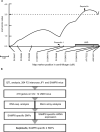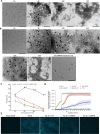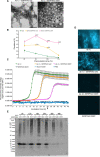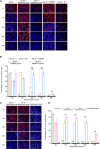Polymorphic SERPINA3 prolongs oligomeric state of amyloid beta
- PMID: 33662018
- PMCID: PMC7932536
- DOI: 10.1371/journal.pone.0248027
Polymorphic SERPINA3 prolongs oligomeric state of amyloid beta
Abstract
Molecular chaperon SERPINA3 colocalizes with accumulated amyloid peptide in Alzheimer's disease (AD) patient's brain. From the QTL analysis, we narrowed down Serpina3 with two SNPs in senescence-accelerated mouse prone (SAMP) 8 strain. Our study showed SAMP8 type Serpina3 prolonged retention of oligomeric Aβ 42 for longer duration (72 hr) while observing under transmission electron microscope (TEM). From Western blot results, we confirmed presence of Aβ 42 oligomeric forms (trimers, tetramers) were maintained for longer duration only in the presences of SAMP8 type Serpina3. Using SH-SY5Y neuroblastoma cell line, we observed until 36 hr preincubated Aβ 42 with SAMP8 type Serpina3 caused neuronal cell death compared to 12 hr preincubated Aβ 42 with SAMR1 or JF1 type Serpina3 proteins. Similar results were found by extending this study to analyze the effect of polymorphism of SERPINA3 gene of the Japanese SNP database for geriatric research (JG-SNP). We observed that polymorphic SERPINA3 I308T (rs142398813) prolonged toxic oligomeric Aβ 42 forms till 48 hr in comparison to the presence wild type SERPINA3 protein, resulting neuronal cell death. From this study, we first clarified pathogenic regulatory role of polymorphic SERPINA3 in neurodegeneration.
Conflict of interest statement
The authors have declared that no competing interests exist.
Figures





Similar articles
-
Polymorphic SERPINA3-R124C reduces pathogenesis of its wild type by shortening the lifetime of oligomeric Aβ.Biosci Biotechnol Biochem. 2021 Jul 23;85(8):1861-1868. doi: 10.1093/bbb/zbab101. Biosci Biotechnol Biochem. 2021. PMID: 34077500
-
MiR-340 Reduces the Accumulation of Amyloid-β Through Targeting BACE1 (β-site Amyloid Precursor Protein Cleaving Enzyme 1) in Alzheimer's Disease.Curr Neurovasc Res. 2020;17(1):86-92. doi: 10.2174/1567202617666200117103931. Curr Neurovasc Res. 2020. PMID: 31957613
-
Evaluation of the Expression of Amyloid Precursor Protein and the Ratio of Secreted Amyloid Beta 42 to Amyloid Beta 40 in SH-SY5Y Cells Stably Transfected with Wild-Type, Single-Mutant and Double-Mutant Forms of the APP Gene for the Study of Alzheimer's Disease Pathology.Appl Biochem Biotechnol. 2017 Nov;183(3):853-866. doi: 10.1007/s12010-017-2468-6. Epub 2017 Apr 17. Appl Biochem Biotechnol. 2017. PMID: 28417423
-
Is Alzheimer's disease a result of presynaptic failure? Synaptic dysfunctions induced by oligomeric beta-amyloid.Rev Neurosci. 2009;20(1):1-12. doi: 10.1515/revneuro.2009.20.1.1. Rev Neurosci. 2009. PMID: 19526730 Review.
-
Amyloid beta-peptide (1-42)-induced oxidative stress and neurotoxicity: implications for neurodegeneration in Alzheimer's disease brain. A review.Free Radic Res. 2002 Dec;36(12):1307-13. doi: 10.1080/1071576021000049890. Free Radic Res. 2002. PMID: 12607822 Review.
Cited by
-
High-Salt Diet Accelerates Neuron Loss and Anxiety in APP/PS1 Mice Through Serpina3n.Int J Mol Sci. 2024 Oct 31;25(21):11731. doi: 10.3390/ijms252111731. Int J Mol Sci. 2024. PMID: 39519278 Free PMC article.
-
Exploring SERPINA3 as a neuroinflammatory modulator in Alzheimer's disease with sex and regional brain variations.Metab Brain Dis. 2025 Jan 4;40(1):83. doi: 10.1007/s11011-024-01523-4. Metab Brain Dis. 2025. PMID: 39754632
-
Elucidation of the neurological effects of clothianidin exposure at the no-observed-adverse-effect level (NOAEL) using two-photon microscopy in vivo imaging.J Vet Med Sci. 2022 Apr 15;84(4):585-592. doi: 10.1292/jvms.22-0013. Epub 2022 Mar 10. J Vet Med Sci. 2022. PMID: 35264496 Free PMC article.
-
Fragmentation of Apolipoprotein E4 is Required for Differential Expression of Inflammation and Activation Related Genes in Microglia Cells.Int J Neurodegener Dis. 2021;4(1):020. doi: 10.23937/2643-4539/1710020. Epub 2021 Sep 10. Int J Neurodegener Dis. 2021. PMID: 34693295 Free PMC article.
-
Spatial Transcriptomic Analysis Identifies a SERPINA3-Expressing Astrocytic State Associated with the Human Neuritic Plaque Microenvironment.bioRxiv [Preprint]. 2024 Nov 14:2024.11.13.623438. doi: 10.1101/2024.11.13.623438. bioRxiv. 2024. PMID: 39605680 Free PMC article. Preprint.
References
Publication types
MeSH terms
Substances
LinkOut - more resources
Full Text Sources
Other Literature Sources
Medical
Molecular Biology Databases
Research Materials
Miscellaneous

